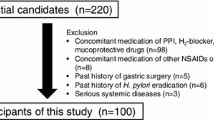Summary
To examine the relation between gastric ulcer (GU) location and serum pepsinogen I (PGI) level, we measured this marker in 284 endoscopically proved GU patients. Their ulcer locations were further divided according to Johnson’s criteria modified to the corpus (type la), gastric angle (type lb), combined with duodenal ulcer (type 2) and prepyloric area (type 3). The numbers of each subset were 96, 81, 58 and 49, respectively. Mean serum PGI level (99.6 ± 44.8 ng/ml) of all GU patients showed no difference from that of their sex and age matched controls. Mean serum PGI levels in both type la and lb patients, did not differ from each other but were significantly lower than in controls, in contrast to those in type 2 and 3 patients which were significantly higher than in controls and comparable to the PGI levels of patients with duodenal ulcer. Smoking did not affect mean serum PGI levels in all subsets except the smoking type 2 patients who manifested a significantly higher mean PGI level. Helicobacter pylori infection did not show different serum PGI levels in any subset. In conclusion, different location of ulcer in the stomach results in a characteristic serum PGI level.
Similar content being viewed by others
References
Graham DY: Campylobacter pylori and peptic ulcer disease. Gastroenterology 1989;96:615–625.
Samloff IM: Peptic ulcer: the many proteinases of aggression. Gastroenterology 1989;96:586–595.
Albillos A, Alvarez-Mon M, Rossi I, et al: Different HCL and pepsinogen I secretion patterns in anatomically defined gastric ulcer subsets. Am J Gastroenterol 1990;85:535–538.
Samloff IM, Liebman WM, Panitch NM: Serum group I pepsinogens by radioimmunoassay in control subjects and patients with peptic ulcer. Gastroenterology 1975;69:83–90.
Kirk RM: Are gastric and duodenal ulcers separate diseases or do they form a continuum? Dig Dis Sci 1981; 26:149–154.
Rotter JI: Gastric and duodenal ulcer are each many different diseases. Dig Dis Sci 1981;26:154–160.
Kang JY: Age of onset of symptoms in duodenal and gastric ulcer. Gut1990;31:854–857.
Mcintosh JH, Byth K, Piper DW: Environmental factors in etiology of chronic gastric ulcer: a case control study of exposure variables before the first symptoms. Gut1985:26:78–798.
Thomas J, Greig M, Mcintosh J, et al: The location of chronic gastric ulcer. Digestion 1980;20;79–84.
Johnson HD; Gastric ulcer: Classification, blood group characteristics, secretion patterns and pathogenesis. Ann Surg 1965;162: 996–1004.
Vianello F, Plebani M, Piccoli A, et al: Role of serum pepsinogen in detecting ulcer disease. Clin Chim Acta 1988:172:335–340.
Huang SC, Miki K, Furihata C, et al: Enzyme-linked immunosorbent assays for serum pepsinogens I and II using monoclonal antibodies-with data on peptic ulcer and gastric ulcer. Clin Chim Acta1988:175:37–50.
Basson M, Modlin IM: Pepsinogen: biological and pathophysiologic significance. J Surg Res 1988:44:82–97.
Chang FY, Lai KH, Lu LC, et al: The relationships between Campylobacter pylori and inflammatory cell infiltration of antral mucosa in patients with dyspepsia. J Formosan Med Assoc 1989:80:8–12.
Brazer SR, Tyor MP, Pancotto FS, et al: Studies of gastric ulcer disease by community based gastroenterologists. Am J Gastroenterol 1990:85:824–828.
Basson MD, Modlin IM: Pepsinogen. J Clin Gastroenterol 1987;9: 475–479.
Ichinose M, Miki K, Furihata C, et al: Radioimmunoassay of serum group I and II pepsinogens in normal controls and patients with various disorders. Clin Chim Acta 1982;126:183–191.
Samloff IM, Stemmermann GN, Heilbrun LK, et al: Elevated serum pepsinogen I and II levels differ as risk factors for duodenal ulcer and gastric ulcer. Gastroenterology 1986;90:570–575.
Richardson CT: Role of aggressive factors in the pathogenesis of peptic ulcer disease. Scand J Gastroenterol 1990;25(suppl 174):37–43.
Card WI, Marks IN: The relationship between the acid output of the stomach following “maximal” histamine stimulation and the parietal cell mass. Clin Sci 1960;19:147–163.
Ruding R: Gastric ulcer and antral border. Surgery 1967;61:495–497.
Baron JH: An assessment of the augmented histamine test in the diagnosis of peptic ulcer. Gut 1963;4:243–253.
Tatsuta M, Ishi H, Okuda S: Location of peptic ulcers in relation to antral and fundal gastritis by chromoendoscopic follow-up examinations. Dig Dis Sci 1986;31:7–11.
Stadelmann O, Elster K, Stolte M, et al: The peptic gastric ulcerhistopographic and functional investigations. Scand J Gastroenterol 1971:6:613–623.
Samloff IM, Varis K, Ihamaki T, et al: Relationships among serum pepsinogen I, serum pepsinogen II, and gastric mucosal histology. Gastroenterology 1982:83:204–209.
Malesci A, Basilico M, Bersani M, et al: Serum pepsinogen I elevation in cigarette smokers. Scand J Gastroenterol 1988;23:602–606.
Miki K, Ichinose M, Shimizu A, et al: Serum pepsinogens as a screening test of extensive chronic gastritis. Gastroenterol Jpn 1987:22:133–141.
Miki K, Ichinose M, Kawamura N, et al: The significance of low serum pepsinogen levels to detect stomach cancer associated with extensive chronic gastritis in Japanese subjects. Jpn J Cancer Res 1989;80:111–114.
Gear NML, Truelove SC, Whitehead R: Gastric ulcer and gastritis. Gut1971;12:639–645.
Lam SK, Lai CL: Gastric ulcers with and without associated duodenal ulcer have different pathophysiology. Clin Sci Mol Med 1978;55:97–102.
Eastwood GL: The role of smoking in peptic ulcer disease. J Clin Gastroenterol 1988;10(Suppl):S19-S23.
Boyd EJS, Wilson JA, Wormsley KG: Smoking impairs therapeutic gastric inhibition. Lancet 1983;l:95–97.
Allen A, Pearson JP, Blackburn A, et al: Pepsins and the mucus barrier in peptic ulcer disease. Scand J Gastroenterol 1988;23(Suppl 146):50–57.
Walker V, Taylor WH: Cigarette smoking, chronic peptic ulceration and pepsin 1 secretion. Gut 1979;20:971–976.
Parente F, Lazzaroni M, Sangaletti O, et al: Cigarette smoking, gastric acid secretion, and serum pepsinogen I concentrations in duodenal ulcer patients. Gut 1985;26:1327–1332.
Rademaker JW, Hunt RH: Acid and barriers, current research and future developments for peptic ulcer therapy. Scand J Gastroenterol 1990;25(suppl 175):19–26.
Yeomans ND: Bacteria in ulcer pathogenesis. Bailliere’s Clin Gastroenterol 1988;2:573–591.
Korman MG: Helicobacter pylori: fact or fiction? Scand J Gastroenterol 1990;25(suppl 175): 159–165.
Author information
Authors and Affiliations
Rights and permissions
About this article
Cite this article
Chang, FY., Lai, KH., Wang, TF. et al. Serum pepsinogen I levels of gastric ulcer patients are determined by the location of the ulcer crater. Gastroenterol Jpn 27, 9–14 (1992). https://doi.org/10.1007/BF02775058
Received:
Accepted:
Issue Date:
DOI: https://doi.org/10.1007/BF02775058




